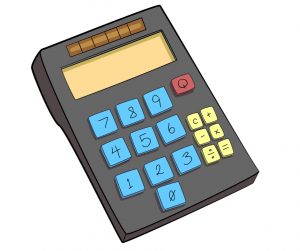How To Calculate Your CGPA in The University: Learning they say; is continuous. It is equally something that takes a gradual process. Knowledge is very important. The main function of the human brain is knowledge accumulation, storage and retrieval of Information stored. These knowledge are gotten from both active and passive learning. Let’s understand what learning is, then we will learn or discuss succinctly on active and passive learning.
Recommended: Tips to Make First class at the University
What is learning?
Learning is a systematic process of acquiring knowledge. It is the process of creating a mental readiness in other to adopt new and defined information through theories or practical means. One has to be ready to learn in other to actually learn. That brings us to the concept of active and passive learning processes.

Active learning is an intentional positioning of the mind and body in a formal or informal environment with a deliberate effort to gain knowledge. In this case, the knowledge might either be entirely new to you or an insight on or exposition to your already acquired knowledge. One of the very distinguishing feature of active learning is that; it is done intentionally through careful preparation and concentration. Passive learning on the other hand is the learning process that doesn’t necessarily require formal preparations and settings to happen.
It is a type of learning process that takes place in informal environment and natural settings. Even though it could take place anywhere and at anytime, it is usually not envisaged or prepared for, rather, it comes as a result of interest capturing, reoccurrences, subtle reminders and many other means. Flowing from the above concepts, we can categorically state that, when it comes active learning, certain establishments or institutions are put in place to effectively impact knowledge through the learning process.
Also see: Countries with the best education system in the world
Such institutions includes the schools, vocational training centers, empowerment hubs and research institutes. Most notable amongst them all is the school setting. School is a formal establishment created as a hub for formal knowledge acquisition and trainings. It is usually a definite structural components with certified tutors who pass knowledge to desirous individuals through a harmonious academic procedure and curriculum. The school system is hierachically organized based on human development and believed brain development and stages.
The category of the school system starts from the creche where toddlers are being taken care of and introduced to a semi-formal learning environment and process. Then there is the nursery section for the children believe to be below the ages of 10. There is also the primary section for youngsters who are percieved to have attained a level of physical and mental development to understand less complex information. Above the primary section is the secondary section where the individual is being introduced to complex knowledge with the aim of broadening their scope of basic understanding and acclimatizing with complex situations.
Then there is the tertiary institutions that are advanced learning institutions with more complex learning procedures and practicals. This is a stage where it is believed that the individual is fully matured and capable of complex learning with insight to logic and reasoning. These are the learning stages as built institutionally.
Also see: How to prepare for an exam in one day
Our main focus would be on the higher or tertiary institution learning environment. The tertiary institution, as we already discussed, is more advanced and at the top of the learning hierachy. It is a place of full human development, self evaluation and self-discovery. It is very diversified. The tertiary institution also known as Universities or college (in some jurisdictions) has a unique system that differentiates it from the lower learning institutions like the primary and secondary levels.
In the the universities, there are more learning areas that are open for studies. More educational materials that students are exposed to for them to take advantage of. The lifestyle and pattern of teaching/learning in the universities are also different. Same goes to the grading system. Amongst many other things, the grading system and how to calculate it in the university is quite unique and a bit complicated when compared to other levels of learning. For beginners, the grading system is known as the point system.

There are basic terminologies used in regards to grading system. Some of these terms includes; Grade Point Average (GPA), Credit Unit (CU), Quality Point (QP) and a few others (we will be making use of these few to drive home our point). It is important to know your grade points in the university, especially for fresh students or those that were newly admitted, the importance can be hinged on the fact that it keeps the student his or her toes in terms of academic performance thereby helping the individual to stay focused. It has been a major challenge learning and understanding how to actually calculate GPA and know your actual grade point or GP. The GP or GPA is usually calculated on a semester basis.
In this section, we will clearly show how GPA can be calculated to aid university students who are really finding it difficult to compute their GPs.
Also see: Highest Paying Companies In the World 2022
How To Calculate Your CGPA In The University
Step 1: The university semester examinations and assessments for courses and modules are classified into Grades represented by letters of the alphabets, ranging from A, B, C, D, E, to F) these are indicators of what a student’s performance looks like in a particular course.

Also see: Most Visited Countries In The World
Step 2: Every Course or module in the university carries a fixed Credit Unit (CU) usually between 2 to 6 CU. Then, Quality points (QP) are gotten from multiplying the Credit Units (CU) of a course by the student’s Grade Point (GP) for the particular course.
Let’s take a look at a practical example of the points explained above:
If student XYZ takes the following courses, English, Literature, Psychology and Philosophy, whatever the student scores in any of these course will have a grade representation of either A, B, C, D, E or F. For Instance, he scores the following marks; English- 70 and above, he will be awarded with an A, Literature – from 50 to 59, he will be awarded a C, Psychology – 40 to 44, he will be awarded a E, Philosophy – 60 to 69, he will be awarded a C. Anything below 40 will attract an F which implies a failure in that particular course.
Another important thing to learn here is that, each score represented by an alphabet has a particular grade point. See below;
A = 5
B = 4
C = 3
D = 2
E = 1
F = 0
Recommended: Fastest Dog Breeds In The World (With Pictures)

To calculate a particular semester GPA, below is a practical example
Where a course is said to be a 3 Credit Unit course, and then a student scores 65% which attracts a B with a Grade Point of 4, the Quality points for the student in that particular course would reflect thus, 3 x 4 = 12. This applies to the other courses the student is studying then, add them up to get your Total Quality Points (TQP).
To get the Grade Point Average (GPA) you have to divide the Total Quality point (TQP) for that semester by the Total Credit Unit (TCU) for that semester. Your Total Credit Unit is a summation of the credit units of all the courses you studied for the semester.
So, where a student earned about 60 quality points in a semester for 18 Credit Units, to get the actual GPA, divide the Quality Points by the Credit Units.
Example; 60/18 = 3.3 GPA.
Step 3: The Cumulative Grade Point Average of a student (CGPA) is gotten by adding the Total Quality Points (TQP) for all the semesters completed and then, dividing it by the Total Credit Units (TCU) for all semesters completed.

Also see: Advantages and Disadvantages of Being an Entrepreneur
Cumulative Grade Point Average (CGPA) of a student can be calculated this;
Where a student earnrd a Quality Point of 58 for 18 Credit Units in her first semester and then earns QP of 70 for 20 CU in her second semester, her CGPA would be represented in this format, TQP/TCU = (58 + 70) / (18 + 20) = 128/38 = 3.3 CGPA.
In conclusion, GPA and CGPA are grading system and evaluation semantics in the university. While GPA is calculated after a semester, CGPA is or can be calculated after a session, comprising two semesters or at the time of graduation to ascertain the overall performance of an individual student.

Edeh Samuel Chukwuemeka, ACMC, is a lawyer and a certified mediator/conciliator in Nigeria. He is also a developer with knowledge in various programming languages. Samuel is determined to leverage his skills in technology, SEO, and legal practice to revolutionize the legal profession worldwide by creating web and mobile applications that simplify legal research. Sam is also passionate about educating and providing valuable information to people.